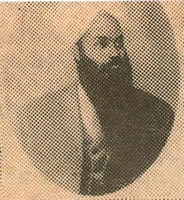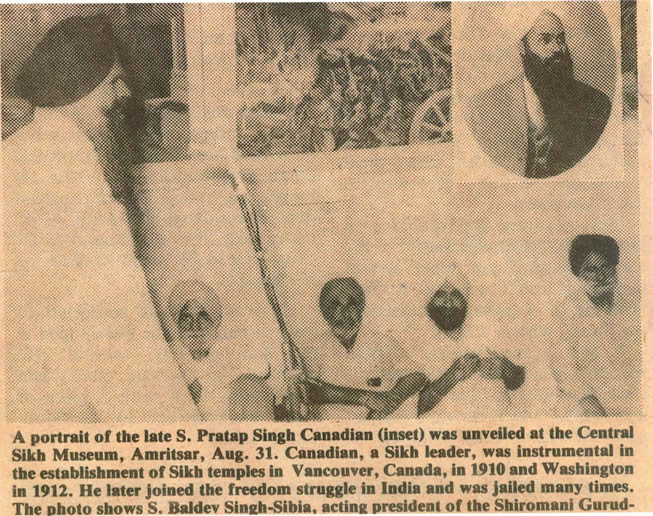Jathedar Partap Singh
Partap Singh was born on October 27, 1882 to Shrimati Jaswant Kaur and Shri Deva Singh of the village Moelawahidpur, Dist. Hoshiarpur, Punjab, India. He got his primary education in his village, middle school at Garhshankar and high school from Govt. High School, Rahon, Dist. Jallandar. He was very interested in history and geography. He had read that America and Canada were very prosperous and progressive countries. He asked his parents if he could go to Canada. His parents were very religious people. They told him that if Sant Atar Singh Masutana would bless him to go to Canada, then they have no objection. According to his parent's wishes, Partap Singh appeared before Santji and told him of his desired to go to Canada. Santji gave him his blessing and rather stressed that he must go to Canada because he was very much needed there by his countrymen and would be very successful whatever in his life's missions. He stayed with Sant Atar Singh for five days and learned about Sikhism and the teachings of honesty and hard work. He was given the name Dharm Singh by Santji. With due respect to both his parents and Santji, he used the name: P.S.Dharm Singh for his business in Canada. He followed Santji's advice for the rest of his life.
He came to Canada in April 1905. He noticed that Indian workers, especially Punjabis were treated badly and with hatred by the whites. The majority of the workers were illiterate, used to smoke, drink and their work ethics were poor. The first thing Partap Singh did was to spread the message of honest work and dignity. He became so popular with Punjabi workers and they started respecting him so much, that they felt proud to go to work through him. He also became very popular with workers from other countries because of his work ethics and honesty. Canadian businesses and farms started hiring workers form him.
P.S. Dharm Singh believed and followed Sikhism all his life. He felt the need to built a Gurdwara in Canada and America and wrote a special letter of request to Santbabaji Atar Singh asking him to come to Canada. Santji asked his special follower, Sant Teja Singh MA,LLB, who was studying at Teachers College, Columbia University in New York during 1908 to meet P.S.Dharm Singh in Canada after he finished his studies. Sant Teja Singh stayed with Partap Singh in Canada for two years (1908-1910).With his loving and impressive preaching, Sant Teja Singh converted hundreds of Punjabis to Amritdhari. Wealthy Canadians and Americans became so impressed with the Sikhdhari worker's work ethics and honesty, that they especially started asking S.Partap Singh to send only Sikhdhari workers to their factories and farms. More and more workers continued to become Sikhdharis. In 1910, Sant Teja Singh helped Partap Singh to built first Gurdwara in Vancouver B.C., Canada under the management of Khalsa Dewan Vancouver.
Punjabi workers in California were very impressed by Partap Singh's efforts to improve Punjabi workers lives in Canada that they requested that he build his headquarters in Stockton, California. Workers in California showed S. Partap Singh so much respect and affection, that he again felt need to built Gurdwara in Stockton, California. He wrote a letter to Sant Teja Singh requesting that he to come to Stockton, California. In 1912, Sant Teja Singh came to Stockton. People came in large numbers from Canada and America to welcome Santji. Under Sant Teja Singh's presence, Doaba Sikh American Education Society and Pacific Coast Khalsa Dewan Society Stockton were established. During the Stockton Gurdwara foundation ceremony, S.Partap Singh, Canadian, Moelawahidpur and S.Harnam Singh, Bhajjal donated large sums of money to build the gurdwara. Lots of money was also given by other sangat. At the same time thousands of U.S. dollars were collected to build Khalsa High School at Pur Heeran, Dist. Hoshiarpur through the Khalsa Educational Society.
During S.Partap Singh's stay in Canada, he continued to spread and preach Gursikhi and freedom spirit in the mind of Punjabis and hatred against slavery in India. He was always very interested in spreading education in Punjab, especially to educate girls. He continued to send money to Punjab for educational purposes through Chief Khalsa Dewan, Amritsar. In September 1912, S.Partap Singh returned to Punjab and also in 1912, Raja Mohinder Partap, Bhai Dashontha Singh Dhada and other Gadari Babas returned to India to start freedom revolution against the British rule. During the summer of 1913, freedom fighters from America and Canada would meet S. Partap Singh in his village, Moelawahidpur, at night to discuss their plans of action against British rule. Unluckily, a traitor gave information to British government regarding their plans of action. The British government stated arresting freedom fighters and putting them in jails. S.Partap Singh and Pundit Salig Ram were arrested at Moelawahidpur and put in the central jail in Lahore. While imprisoned, they were tortured for three years. In 1916, the British had to release them because of lack of evidence against them. S.Partap Singh was told by the British authorities that he could not leave his village for three years and had put restrictions on all his activities including lectures, writing in newspapers or meeting with any freedom fighters. A Police chocki was set up at his village, Moelawahidpur, to watch his activities and S. Partap was made to pay all their expenses. Inspite of all these restrictions, he continued the freedom struggle along with other freedom lovers. During the house arrest period, he built a Gurdwara in his village. S. Partap Singh created Punchati raj in his village and all village legal matters were resolved locally with no cases going to the government court. He also employed a teacher to go to village homes to motivate villager to start educating their girls.
During Feb.1920, the British lifted restrictions on S. Partap's movements. He was invited by Shodi Pritam Singh Anandpuri to visit Anandpursahib, which he gracefully accepted. Later as a Jathedar, he made many good changes at Anandpur Gurdwara. He went to jail many times during freedom struggle. In 1924, he was again released from jail and after his release SGPC Amritsar made him again Jathethar of Takhat Shri Kashgarh Sahib. He served faithfully at this position for almost 20 years. With the help of Sant Harnam Singh and Sant Hari Singh Kaharpuri, Partap Singh successfully built the beautiful Takhat Keshgarh Sahib Gurdwara.
After 20 years of service at the above holy place, he returned to his village. He spent most of his time doing kirtan gurbani and prayer. On Feb.9, 1947 about 2.30 PM, he called his son and told him that he was ordered by the Almighty to leave this world and Sant will come to take him. "Send me with him with a smile and no on will cry on my departure." On Feb.10, 1947 at exactly 2.30 PM while Partap Singh was laying in his bed he again told his son who was sitting by his bed side, and Jathedarji smiled and said Santji had come and his soul left his body peacefully. According to his wishes, Santsamelan was done on Feb.21, 1947. All prominent Sants and Akali leaders came to celebrate his life achievements and to pay homage and show their respect to this freedom fighter gadaribaba named Jathedar Partap Singh. To show further respect to him, SGPC Amritsar inducted the Partap Singh, Canadian portrait and life history into the Central Sikh Museum at the Golden Temple, Amritsar. S. Baldev Singh Sibia, Acting Chairman SGPC, conducted this historical ceremony. Jathedar Partap Singh's life history is also written and published by the Information Department of Punjab Government in a book called Freedom Fighters from district Hoshiarpur (Jila Hoshiarpur De Sutantarta Sangramis) under the title AMAR SAHID on page 91 along with his photograph.
References
P.S. - This information is from life history of Partap Singh written by his son Gurdial Singh Mahi BA, LLB; who was also involved in India's freedom movement and watched his father's freedom struggle along with other Gadari during his childhood.
This life history in written by Dr. Nazar Chauhan and Parminder Kaur Chauhan, his granddaughter.


